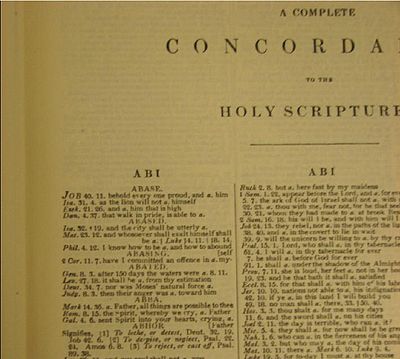
Cruden's Concordance
Encyclopedia

Bible concordance
A Bible concordance is a verbal index to the Bible. A simple form lists Biblical words alphabetically, with indications to enable the inquirer to find the passages of the Bible where the words occur....
of the King James Bible (KJV) that was singlehandedly created by Alexander Cruden
Alexander Cruden
Alexander Cruden was the author of an early concordance to the Bible, and also served as Alexander the Corrector, a self-styled national corrector of signs, books and morals.-Early life:...
(1699-1770). It was first published in 1737 and has not been out of print
Out of print
Out of print refers to an item, typically a book , but can include any print or visual media or sound recording, that is in the state of no longer being published....
since then.
Cruden's concordance was first published in 1737, one of the first copies being personally presented to Queen Caroline
Caroline of Ansbach
Caroline of Brandenburg-Ansbach was the queen consort of King George II of Great Britain.Her father, John Frederick, Margrave of Brandenburg-Ansbach, was the ruler of a small German state...
on November 3, 1737. Cruden began work on his concordance in 1735 whilst a bookseller in London. Cruden worked alone from 7am to 1am every day and completed the bulk of the work in less than a year. The proofreading and layout took a little longer. His brain was occupied with nothing else, so much so that he failed to notice the diminishing stock in his bookshop and the consequent lack of custom. "Was there ever, before or since the year 1737", writes his biographer Edith Olivier, "another enthusiast for whom it was no drudgery, but a sustained passion of delight, to creep conscientiously word by word through every chapter of the Bible, and that not once only, but again and again?".
Although a remarkable feat, the concordance was not entirely without error. The Times
The Times
The Times is a British daily national newspaper, first published in London in 1785 under the title The Daily Universal Register . The Times and its sister paper The Sunday Times are published by Times Newspapers Limited, a subsidiary since 1981 of News International...
recorded that Cruden left out Buz (brother of Huz) and Sneeze (put under Neeze).
See also
- Strong's ConcordanceStrong's ConcordanceStrong's Exhaustive Concordance of the Bible, generally known as Strong's Concordance, is a concordance of the King James Bible that was constructed under the direction of Dr. James Strong and first published in 1890. Dr. Strong was Professor of exegetical theology at Drew Theological Seminary at...
- Young's Analytical Concordance to the BibleYoung's Analytical Concordance to the BibleYoung's Analytical Concordance to the Bible is a concordance to the Bible compiled by Robert Young first published in 1879.-Contents:* Hints and Helps to Bible Interpretation...

